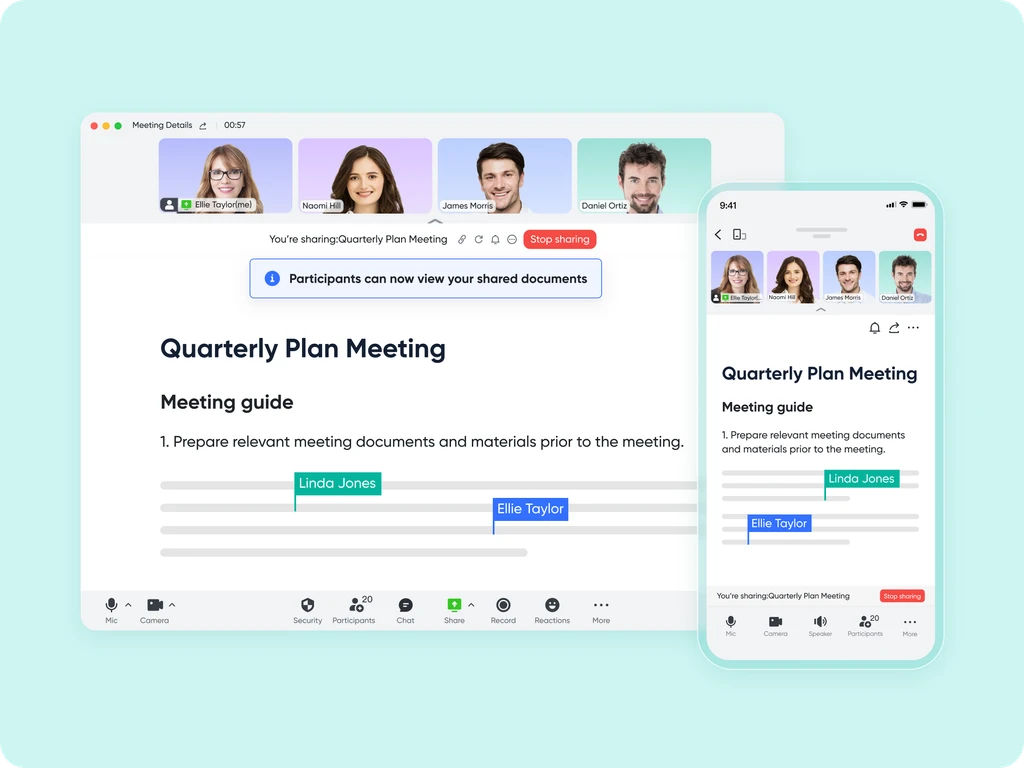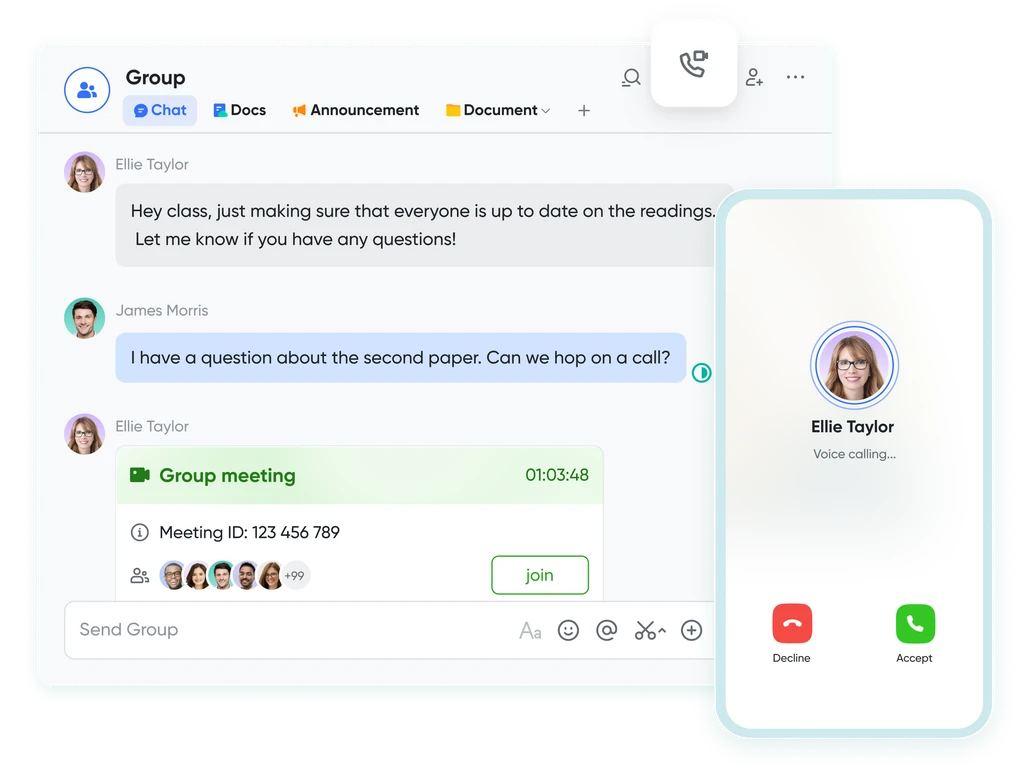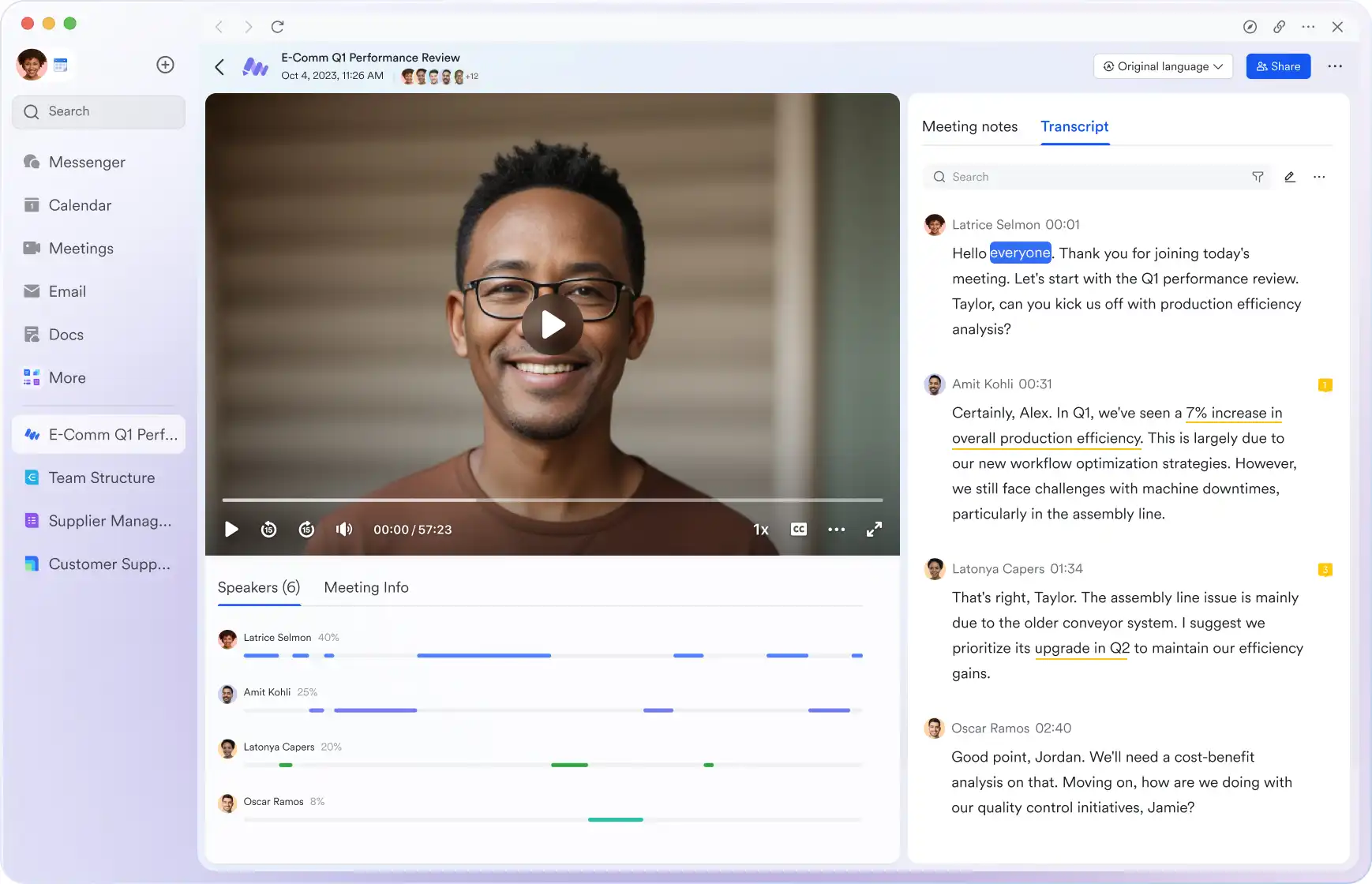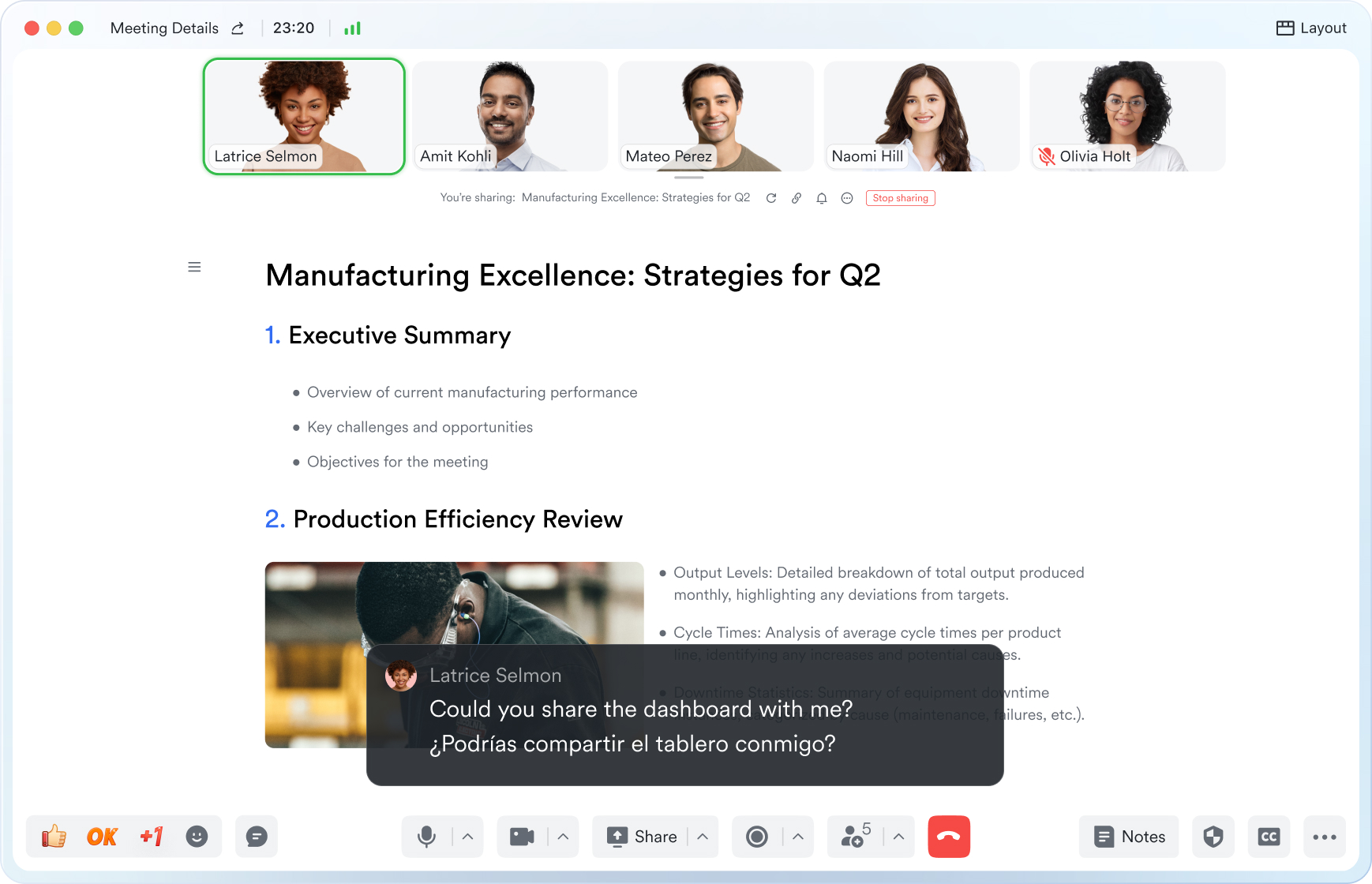Stand Up Meeting
This guide will walk you through the essential elements of use stand up meeting to keep your attendees aligned and engaged.
Try Lark for Free
In today's fast-paced work environments, optimizing daily team gatherings is crucial for seamless collaboration and goal achievement. One such effective approach is the stand-up meeting. This article delves into the intricacies of hosting a successful stand-up meeting in 2024, equipping you with comprehensive insights, practical examples, and actionable guidelines to enhance the efficiency of your team interactions.
Use Lark Meetings to turn meetings into true collaborative experiences.
What is a stand-up meeting?
A stand-up meeting, also known as a daily scrum, is a brief, time-boxed event in the agile development methodology. It is a pivotal component of the agile framework, designed to bring team members together for succinct updates and coordination. The meeting typically involves standing to encourage brevity and promptness and lasts no longer than 15 minutes. During this time, team members share progress updates, identify potential impediments, and synchronize their efforts towards accomplishing the established goals.
Goals of a stand-up meeting
The primary goals of a stand-up meeting are to foster collaboration, enhance visibility, and promote accountability within the team. By providing a platform for daily synchronization, stand-up meetings facilitate a collective understanding of individual tasks, project impediments, and achievements. Moreover, they serve as a mechanism for identifying potential bottlenecks, coordinating efforts, and adapting to changing priorities, ultimately driving continuous improvement and efficiency.
Who should attend a stand-up meeting?
In an ideal setting, a stand-up meeting includes the entire development team, irrespective of its size. This encompasses the development team, ScrumMaster, and the product owner, ensuring comprehensive representation and participation. Additionally, cross-functional team members and stakeholders involved in the project may attend as observers, contributing insights for refined decision-making and collaboration.
Learn more about Lark x Meetings
Topics, agenda, and structure of a stand-up meeting
A well-structured stand-up meeting comprises three fundamental questions that each team member answers in turn:
- What did I accomplish yesterday?
- What will I do today?
- Are there any impediments in my way?
The meeting should be time-boxed and structured to ensure that discussions remain focused and concise. A suggested agenda may include:
- Start with a brief introduction or welcoming remarks
- Each team member provides their update, answering the three core questions
- Open the floor for quick discussions on any identified obstacles or potential collaborations
Learn more about Lark x Meetings
How often should stand-up meetings occur?
The frequency of stand-up meetings is typically daily. However, the frequency may vary based on factors such as team size, project complexity, and the organization's specific needs. Continuous communication and synchronization are pivotal in determining the optimum frequency to balance efficiency and respect for team members' time.
Key differences between stand-up meetings and other similar gatherings
Stand-up meetings differentiate themselves from conventional meetings through their brevity and focus on daily synchronization. Unlike lengthier meetings, stand-up meetings prioritize prompt updates, issue identification, and quick problem-solving. Additionally, stand-up meetings are distinct from brainstorming sessions as they primarily center on progress updates and impediment resolution rather than generating new ideas.
Learn more about Lark x Meetings
Three practical examples of successful stand-up meetings
Technology department - xyz tech solutions
Technology department - xyz tech solutions
In this context, the technology team at XYZ Tech Solutions leveraged stand-up meetings to enhance visibility and coordination within their diverse development projects. By conducting virtual stand-up meetings, the team maintained seamless communication, swiftly addressed impediments, and realized notable improvements in project delivery timelines.
Marketing team - innovate marketing agency
Marketing team - innovate marketing agency
The marketing team at Innovate Marketing Agency adopted a hybrid approach to stand-up meetings, blending in-person and virtual interactions to accommodate remote team members. This approach fostered widespread engagement and facilitated cross-functional collaboration, enabling the team to align on strategic priorities effectively.
Customer service division - superior support inc.
Customer service division - superior support inc.
At Superior Support Inc., stand-up meetings became instrumental in addressing evolving customer service challenges. The division utilized stand-up meetings to share valuable customer insights, coordinate individual efforts, and swiftly adapt to changing customer needs, resulting in enhanced service quality and customer satisfaction.
Common pitfalls of stand-up meetings
Amid their benefits, stand-up meetings can encounter several challenges, including:
- Overextended Discussions: Straying away from the brief nature of stand-up meetings, leading to prolonged and unfocused discussions.
- Lack of Active Engagement: Limited participation and engagement from team members, diminishing the meeting's effectiveness.
- Inadequate Follow-up: Failure to address identified impediments and action items post the meeting, resulting in recurrent issues.
Related:
Master the Art of Meeting Notes with Lark for Enhanced Collaboration | Lark Blog | Lark BlogLearn more about Lark x Meetings
Dos and don'ts of a stand-up meeting
| Do's | Don'ts |
|---|---|
| 1. Encourage active participation | 1. Initiate lengthy discussions |
| 2. Maintain a time-boxed meeting | 2. Ignore identified impediments |
| 3. Address impediments promptly | 3. Disregard updates from team members |
| 4. Facilitate open and inclusive discussions | 4. Overwhelm the team with unnecessary details |
| 5. Document key takeaways and action items | 5. Deviate from the core agenda |
Facilitating virtual stand-up meetings for success
In the current dynamic work landscape, virtual stand-up meetings have become increasingly prevalent. To ensure their success, consider the following practices:
- Leverage reliable and immersive communication platforms to accommodate remote team members.
- Encourage the use of video conferencing to foster a sense of presence and engagement among virtual participants.
- Utilize digital collaboration tools for real-time updates and efficient task tracking.
Related:
Unlock the Power of Webinars: A Comprehensive Guide to Boost Your Business | Lark Blog | Lark BlogLearn more about Lark x Meetings
Typical takeaways from stand-up meetings
- Enhanced Team Cohesion: Stand-up meetings facilitate team alignment, camaraderie, and a collective focus on common objectives.
- Continuous Improvement: The identification of impediments and action items during stand-up meetings drives iterative improvements in processes and project execution.
- Streamlined Communication: Clear and concise updates contribute to efficient communication, minimizing misunderstandings and misalignments.
Key questions to ask during a stand-up meeting
- What progress have you made since the last stand-up meeting?
- Are there any obstacles impeding your current tasks?
- What are your planned activities until the next stand-up meeting?
- Do you foresee any potential risks or challenges in achieving your assigned tasks?
- How can the team support your current initiatives or identified impediments?
Learn more about Lark x Meetings
Conclusion
In conclusion, maximizing the potential of stand-up meetings in 2024 demands thoughtful planning, effective execution, and continuous refinement. By cultivating a collaborative environment, harnessing the power of concise communication, and leveraging actionable insights from stand-up meetings, teams can substantially elevate their productivity and drive impactful outcomes.
Use Lark Meetings to turn meetings into true collaborative experiences.
A Game Changer for Stand Up Meeting: Empower your team with Lark Meetings
In the fast-paced and dynamic world of modern business, effective communication and collaboration are crucial for success of Stand Up Meeting. Here we introduce Lark Meetings to serve as a centralized hub for all communication needs.
Transform your meetings into collaborative endeavors

Leverage the potency of in-call document sharing, intelligent meeting minutes, and mobile-optimized features to enhance productivity collaboratively, irrespective of your location or schedule.
Seamlessly collaborate in real-time, across any device

Share live documents instead of just screen views. Participants can navigate and edit simultaneously within the video call window, even while on the move.
Shift your focus to engagement, not note-taking

Lark Minutes automatically converts video meetings into transcripts, facilitating easy viewing, searching, and collaborative editing. Stay in the loop asynchronously, even if you can't attend the live meeting. Lark Minutes for meeting minutes support translation into 10+ different languages.
Break language barriers in communication

Lark Meetings provide real-time translation for subtitles, allowing individuals from diverse backgrounds to express themselves in their native languages. Ensure every voice is heard, regardless of geographical location. Live subtitles currently support translations from English, Chinese, and Japanese to 10+ different languages. See more translation feature in Lark.
Connect with larger audiences
Host dynamic online meetings and events accommodating up to 1,000 participants, with the flexibility of up to 50 breakout sessions for intimate group discussions within the larger meeting context. Try more Lark features for free.








